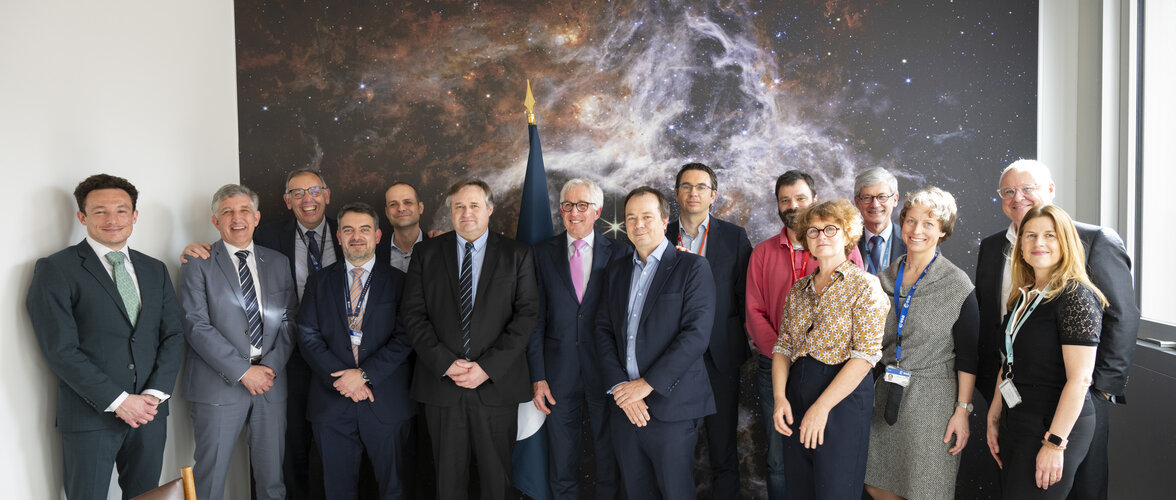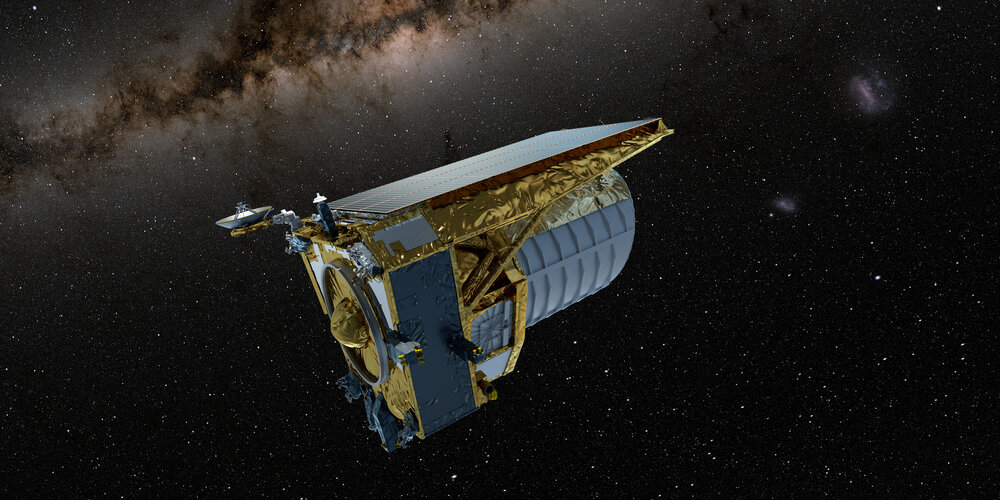
Copernical Team
ESA kicks off two new navigation missions

ESA has signed contracts with several European companies for an overall amount of € 233 million to develop Genesis and a LEO-PNT demonstrator, two new missions within the FutureNAV programme that will keep Europe at the forefront of satellite navigation worldwide.
Ellipspace to Unveil Comprehensive Satellite Network by 2027
 Ellipspace, a pioneering Beijing-based satellite firm, is on track to create a comprehensive satellite network, dubbed Starpool, aimed at enhancing capabilities across various sectors, including emergency services and infrastructure monitoring. The network, poised for completion in 2027, will comprise over 100 satellites, significantly advancing global satellite services.
Di Fengping, Elli
Ellipspace, a pioneering Beijing-based satellite firm, is on track to create a comprehensive satellite network, dubbed Starpool, aimed at enhancing capabilities across various sectors, including emergency services and infrastructure monitoring. The network, poised for completion in 2027, will comprise over 100 satellites, significantly advancing global satellite services.
Di Fengping, Elli Hughes' JUPITER 3 Satellite Revolutionizes Connectivity Across the Americas
 Hughes Network Systems, LLC (HUGHES), a subsidiary of EchoStar Corporation (Nasdaq: SATS), has officially announced the commencement of services by its JUPITER 3 satellite to customers in various countries including the United States, Canada, Mexico, Brazil, Peru, Ecuador, Argentina, and Colombia. Launched in July 2023, JUPITER 3 reached its designated orbit at the 95 West slot swiftly and was s
Hughes Network Systems, LLC (HUGHES), a subsidiary of EchoStar Corporation (Nasdaq: SATS), has officially announced the commencement of services by its JUPITER 3 satellite to customers in various countries including the United States, Canada, Mexico, Brazil, Peru, Ecuador, Argentina, and Colombia. Launched in July 2023, JUPITER 3 reached its designated orbit at the 95 West slot swiftly and was s Kanyini Satellite Clears Environmekanyini-satellite-modelntal Stress Test
 The Kanyini satellite, based in South Australia, has successfully completed a significant Environmental Stress Screening (ESS) milestone, a critical step in preparation for its scheduled mid-2024 launch. Conducted at the Advanced Instrumentation and Technology Centre of the Australian National University in Canberra, the ESS tested the satellite against severe space conditions including extreme
The Kanyini satellite, based in South Australia, has successfully completed a significant Environmental Stress Screening (ESS) milestone, a critical step in preparation for its scheduled mid-2024 launch. Conducted at the Advanced Instrumentation and Technology Centre of the Australian National University in Canberra, the ESS tested the satellite against severe space conditions including extreme LizzieSat signals success for Sidus Space in post-launch phase
 Sidus Space, Inc. (NASDAQ: SIDU), a pioneering Space and Data-as-a-Service satellite enterprise, confirmed the successful reception of signals from its LizzieSat satellite subsequent to its deployment into low Earth orbit via SpaceX's Transporter-10 Rideshare mission launched on March 4, 2024, from the Space Launch Complex 4 East at Vandenberg Space Force Base, California.
The operation ce
Sidus Space, Inc. (NASDAQ: SIDU), a pioneering Space and Data-as-a-Service satellite enterprise, confirmed the successful reception of signals from its LizzieSat satellite subsequent to its deployment into low Earth orbit via SpaceX's Transporter-10 Rideshare mission launched on March 4, 2024, from the Space Launch Complex 4 East at Vandenberg Space Force Base, California.
The operation ce QuickLogic and Zero-Error Systems radiation-resistant eFPGA IP for space
 QuickLogic Corporation (NASDAQ: QUIK), specializing in embedded FPGA (eFPGA) IP, ruggedized FPGAs, and Endpoint AI/ML solutions, has forged a strategic partnership with Zero-Error Systems America (ZES), renowned for its radiation-hardened-by-design (RHBD) semiconductor solutions and intellectual property (IP). This alliance is set to develop radiation-tolerant eFPGA IP tailored for the burgeonin
QuickLogic Corporation (NASDAQ: QUIK), specializing in embedded FPGA (eFPGA) IP, ruggedized FPGAs, and Endpoint AI/ML solutions, has forged a strategic partnership with Zero-Error Systems America (ZES), renowned for its radiation-hardened-by-design (RHBD) semiconductor solutions and intellectual property (IP). This alliance is set to develop radiation-tolerant eFPGA IP tailored for the burgeonin Euclid's Mission to Clear Vision: Innovative De-Icing Operations Commence
 In a pioneering step towards maintaining the integrity of its mission, Euclid teams across Europe have embarked on a critical operation to remove thin layers of water ice affecting the spacecraft's optics. This ice, measuring just a few nanometers in thickness, has started to slightly diminish Euclid's ability to capture the universe's dark mysteries with its unparalleled precision. The success
In a pioneering step towards maintaining the integrity of its mission, Euclid teams across Europe have embarked on a critical operation to remove thin layers of water ice affecting the spacecraft's optics. This ice, measuring just a few nanometers in thickness, has started to slightly diminish Euclid's ability to capture the universe's dark mysteries with its unparalleled precision. The success Revolutionary Laser Technology Shapes the Future of Space Exploration
 A groundbreaking laser beam, reminiscent of a light sabre, is making waves in technological advancements through its innovative guidance via a hair-thin water jet, mirroring the function of traditional fibre optics.
The water jet's significant 'processing depth' facilitates the parallel slicing of larger specimens, simultaneously providing continuous cooling to the cut zone and the efficie
A groundbreaking laser beam, reminiscent of a light sabre, is making waves in technological advancements through its innovative guidance via a hair-thin water jet, mirroring the function of traditional fibre optics.
The water jet's significant 'processing depth' facilitates the parallel slicing of larger specimens, simultaneously providing continuous cooling to the cut zone and the efficie Leonid Capital Partners Invests $6.25 Million in Space Propulsion Innovator Phase Four
 Leonid Capital Partners, an investment firm specializing in high-growth tech ventures in the National Security sector, today unveiled a $6.25 million investment in Phase Four, a pioneering company at the forefront of developing propulsion technologies for future space vehicles. This financial injection underlines Leonid Capital Partners' commitment to advancing the next generation of space explo
Leonid Capital Partners, an investment firm specializing in high-growth tech ventures in the National Security sector, today unveiled a $6.25 million investment in Phase Four, a pioneering company at the forefront of developing propulsion technologies for future space vehicles. This financial injection underlines Leonid Capital Partners' commitment to advancing the next generation of space explo Operations begin to de-ice Euclid’s vision

A few layers of water ice – the width of a strand of DNA – are starting to impact Euclid’s vision; a common issue for spacecraft in the freezing cold of space, but a potential problem for this highly sensitive mission that requires remarkable precision to investigate the nature of the dark Universe. After months of research, Euclid teams across Europe are now testing a newly designed procedure to de-ice the mission's optics. If successful, the operations will validate the mission teams’ plan to keep Euclid’s optical system as ice-free as possible for the rest of

